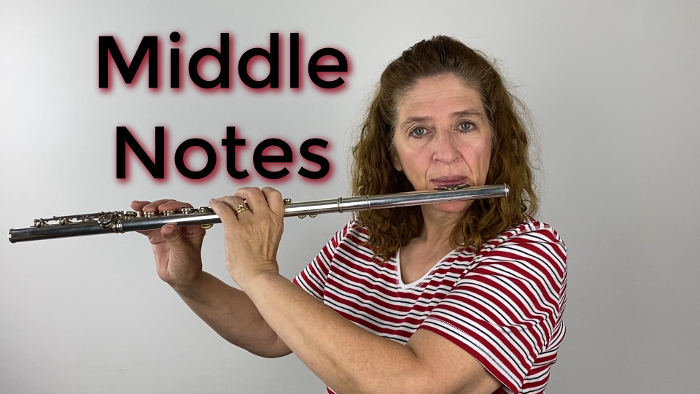How are your middle register notes? Not the best? This is a very common problem. These pesky notes can be difficult to get a good tone quality. The tone on these middle notes is often thin at best. What is the reason for that and how do you fix it?
The reason that the sound is bad is because it is more difficult to achieve harmonics when the flute is essentially shorter. However, there are ways to work with the flute and get these harmonics in the tone.
It’s been my experience that students have a difficult time getting a quality sound on these middle register notes. Part of that reason has to do with the fact that when you play a C, you’re making your instrument essentially shorter and the shorter the instrument the more difficult the sound. We have to work a little bit harder to get the sound that we’re looking for in that register to match the top register and the bottom register. It’s not easy to get a good, rich, low register sound but it’s easier than these middle notes. And once we get past that middle E flat, the tone comes back to normal because we’ve got almost all the fingers down and that first finger is down.
Let’s talk a little bit about how you can work on these notes. Practicing long tones would of course, be one way to work on these notes. Now, I think that the two-note long tones may not be the exercise to work on these middle notes. And by two-note I mean the Moyse long tones. Those are great and yes, work on long tone! But I think a good place to start is to play long tones that go through that middle register. What is mean is that you begin with a great note that works for you, and then chromatically and slowly play through the Eb, D, C#, and C. If you begin with a note that you can play well, then you can hear when the tone changes and you can work on making the tone stay the same.
A good note to begin on is the middle register F. Now get the best tone that you can on that F. Make sure your embouchure does not keep the air too low. You want to keep the air pretty much at that same angle. You don’t want to be moving the air stream. Now, play through those notes and see how consistent you can keep that tone.
Play nice and slow so you can think about what’s going on in your throat and your embouchure. The number one issue that gives those middle register notes such a thin sound is changing of the throat or the embouchure in the wrong way or not changing it at all. If I keep the air too high, or I tighten up my throat, or I let my embouchure change in some way that isn’t conducive to getting a good tone, then my tone will be affected. Keep that throat open as you move through these notes. Don’t change!
The second thing that affects the tone is not an obvious thing, but I find that students move their hands too much. This extra movement, especially when moving to a C sharp, affects the tone. It makes the embouchure move and the angle of air to move. You must keep in mind that everything you do is connected.
So, your number one reason for getting a better tone is to keep your embouchure and your throat open. The number two reason is to make sure that your hands stay in the same position and don’t let them move.
These are just different techniques of working on those middle notes. Now go and find some music that you are working on and find a middle range section and analyze what is going on with your middle register notes. Start working on it and see if are you changing your hand positions. Are you closing your throat? Is your embouchure changing in a bad way? Is your air too high? You can fix these notes and get a tone that matches all your other registers!
Have fun!
DoctorFlute
Watch me demonstrate this idea:
Getting a Better Tone Quality on Your Middle Notes C C# D Eb – FluteTips 161

How Not to Crack on Your Middle Register Notes – FluteTips 164

Experimenting with Tone – FluteTips 176

Finding Your Tone with a New Headjoint – FluteTips 158

Practice Articulation to Improve Your Tone – FluteTips 155

